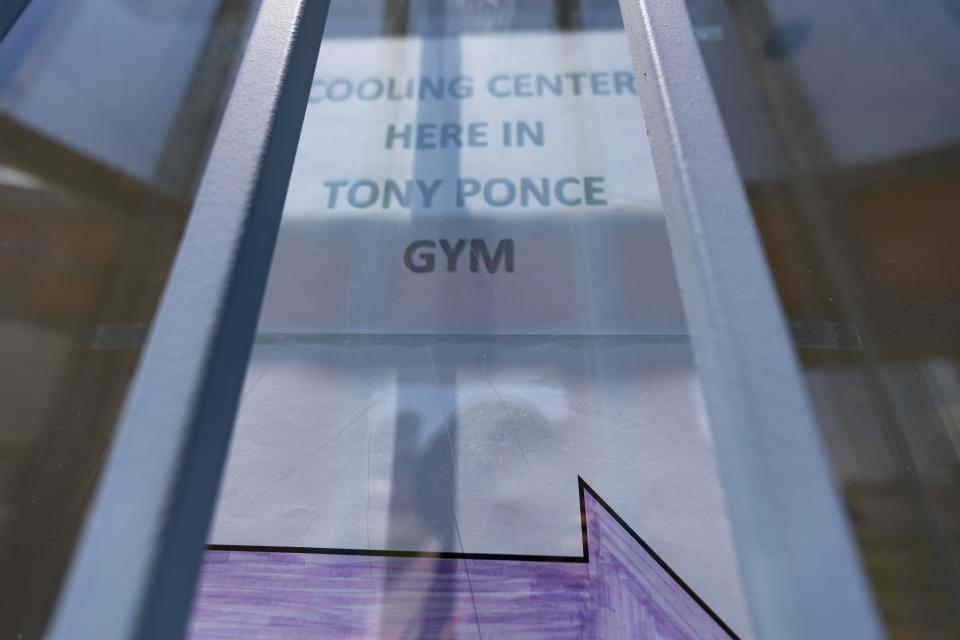Emergency room visits and 911 calls for heat illness spike during Texas heat wave
Record-setting heat in Texas has sent hundreds of people to emergency rooms in recent weeks, according to state health officials.
The El Paso Fire Department said Wednesday that in the past seven days, 26 heat-related emergencies were recorded, with 19 resulting in transport to a medical facility.
Temperature records fell across Texas during the past two weeks, putting June 2023 on pace to be the hottest June ever in some parts of the state. From the border city of Del Rio to the capital city, Austin, temperatures hit triple digits for days straight.
Emergency medical providers are responding to heat-related illnesses as extreme temperatures become more frequent and prolonged. On June 20, at least 350 people visited emergency departments across Texas because of heat illnesses, according to state health officials. That was the highest number of ER visits for heat-related illnesses on any single day in 2022 or 2023 so far. Not all hospitals and clinics are included in the state data, so the total is likely an undercount.
Emergency Medical Services in Texas cities also reported high numbers of calls for heat-related illnesses this month. Houston EMS fielded 416 calls related to heat illnesses in the first 23 days of June. Even Texans accustomed to hot weather have been taken aback by the dangerous conditions.
“We are on pace to beat our numbers from last June,” said Austin-Travis County EMS paramedic and spokesperson Christa Stedman. “And that was the hottest June on record.”
More: City of El Paso opens cooling centers as high temperatures hit Borderland

Hotter summers linked to climate change have deadly toll in Texas
Chris Mendoza once landed in the hospital with heat stroke from working inside a food truck. After that experience, he set a rule for the food truck he now owns in El Paso, Star Burgers & Fries, which serves Star Wars-themed hamburgers. “Once the internal temperature of the truck hits 140, we have to shut down,” he said.
On Monday, the high temperature in the desert city was 110 degrees; inside the food truck was even hotter. That evening he suspended service for an hour because it was too hot to work safely. “I’d rather lose a customer than make a burger, because I care more about people’s health than the profit,” Mendoza said.
The heat wave has posed a health risk to millions of Texans, especially those who work outside or are homeless. While final autopsies are still pending, several deaths already have been linked to the extreme heat.
A utility lineman died June 19 in East Texas after he had been treated for a heat-related illness. A Dallas postal worker died June 20. The next day, a 17-year-old died after collapsing at a state park outside Amarillo. A 14-year-old male hiker died June 23 in Big Bend National Park, where temperatures topped 119 degrees, and his stepfather died when he crashed his vehicle seeking help.
Emergency responders also have found several deceased individuals in the desert along the U.S.-Mexico border in recent days. Since June 22, five bodies have been recovered in Sunland Park, New Mexico, just over the border from Texas and a common crossing point for migrants in the El Paso-Juárez area. The causes of death and the individuals’ identities have not been disclosed.
Climate change made the extreme heat wave more likely to occur, according to the Climate Shift Index, a tool developed by the science nonprofit Climate Central to estimate how much more likely a specific weather event is because of climate change.
The Climate Shift Index analyzes the temperatures of a 31-day period surrounding a specific date in our current climate. Andrew Pershing, vice president for science at Climate Central, said the organization then removes the signal of global warming to assess how frequent those temperatures would be in a world where “humans hadn’t put a lot of things in the atmosphere and warmed things up.”
The recent heat wave scored five, meaning it was five or more times likelier because of climate change. “At that level, you are looking at an event that is highly, highly unlikely without climate change,” Pershing said.
Last year, a study found one additional day of extreme heat, or with a heat index of over 90 degrees, was associated with a 0.07 increase in the mortality rate.
According to a Texas Tribune analysis, at least 279 people died due to heat in Texas during 2022 and roughly half were residents of another state or country, who most likely died after crossing the U.S.-Mexico border. The analysis found heat deaths in 2021 and 2022 in Texas surpassed recent years, including 2011, when the state experienced historically hot and dry conditions.
The scorching start to summer 2023 means that heat-related deaths could continue to rise.
More: Donate a fan to help save your neighbor from summer heat in El Paso

Emergency medical professionals respond to more heat-related illnesses
Emergency room doctors and emergency medical technicians across the state are treating patients with symptoms of heat stroke or exhaustion.
On June 20, the Texas Syndromic Surveillance system, which includes data from 80% of the state’ hospitals, recorded approximately 350 people who visited an emergency department because of the heat. Also on June 20, the heat-related illness rate in Texas surpassed 1,000, meaning that at least one in every 100 ER visits was heat-related, according to the CDC’s Heat & Health Tracker.
Auden Velasquez, a family doctor at Pecos County Memorial Hospital in Fort Stockton, said West Texans are generally prepared for extreme heat. “It’s something that we expect and people are smart about it,” Velasquez said. “But certain people don’t have the option of getting out of the sun, like oilfield workers or construction workers.”
High temperatures in Fort Stockton, midway between El Paso and San Antonio, have fluctuated between 100 and 110 for the past week. Velasquez said the hospital also treats patients who have crossed the U.S.-Mexico border and are brought in by Border Patrol after they suffered heat illnesses.
More: Bodies found in Sunland Park, NM, desert as border heat wave continues
EMS providers across the state have reported high numbers of heat-related 911 calls this month. Houston EMS responded to 416 heat-related calls between June 1 and June 23. San Antonio EMS fielded 234 calls for heat-related health problems between June 1 and June 25, compared with 163 during the same period in 2022. Calls spiked during the week of June 19, when 98 people sought aid for heat-related illness.
MedStar, the EMS authority for Fort Worth and other North Texas cities, responded to 25 patients experiencing heat-related illnesses on June 26 alone. Austin-Travis County EMS responded to 151 heat-related calls between June 1 and 25. Seventy-six of those calls came in last week, when temperatures in Austin topped 100 degrees for days.
Christa Stedman of Austin-Travis County EMS said the department responds to other heat-related incidents that do not show up in that statistic. For example, if a bystander calls 911 for an unconscious person outdoors, the initial report may not be classified as heat-related, even if the medics later determine that cause.
The true health toll of the Texas heat wave is still coming into focus. But with a long summer ahead, the necessity of preparing for extreme heat is clear.
Martha Pskowski covers climate change and the environment in Texas from her base in El Paso. She was previously an environmental reporter at the El Paso Times. She began her career as a freelance journalist in Mexico, reporting for outlets including The Guardian and Yale E360. Martha has a Bachelor of Arts in Environmental Studies from Hampshire College and a master’s degree in Journalism and Latin American Studies from New York University. She is a former Fulbright research fellow in Mexico. She may be reached at martha.pskowski@insideclimatenews.org and @psskow on Twitter.
Gina Jiménez is a New York-based bilingual journalist focused on environmental health and policy and how they affect disadvantaged communities. She is currently enrolled in the Science, Health, and Environmental Reporting Program at New York University. She may be reached at gina.jimenez@insideclimatenews.org.
This report originally was published on https://insideclimatenews.org.
This article originally appeared on El Paso Times: 100-plus degree weather sends hundreds in Texas to emergency rooms

